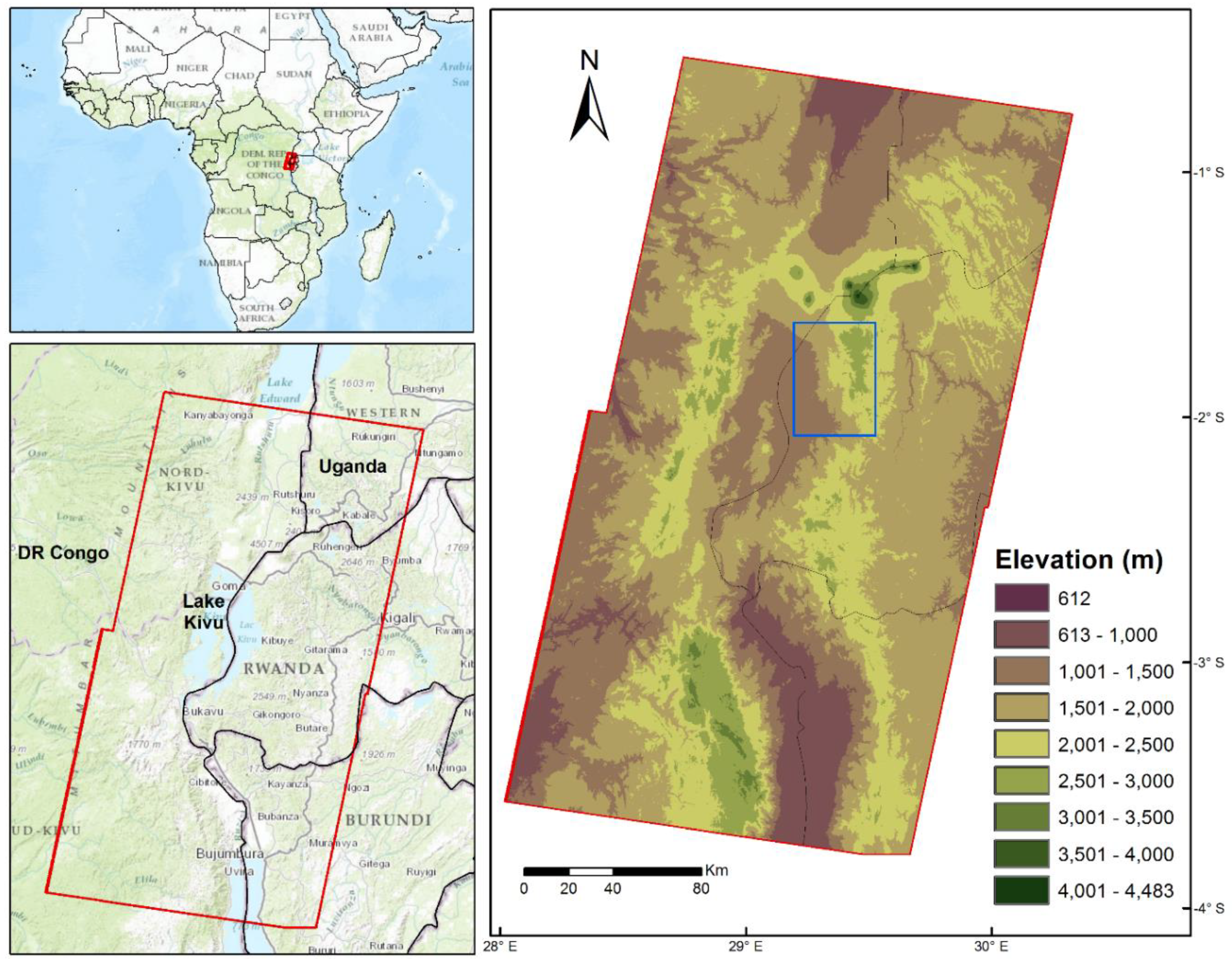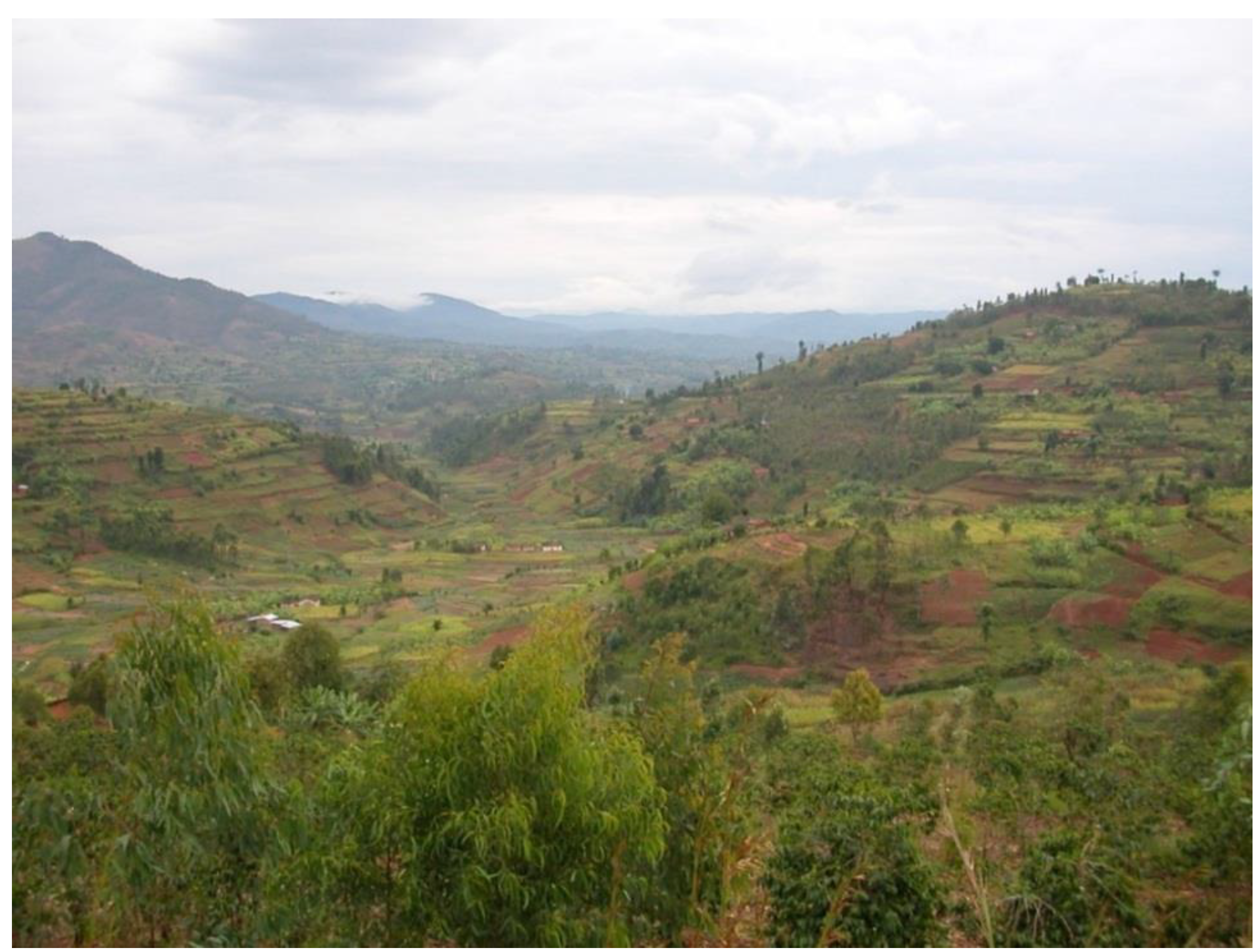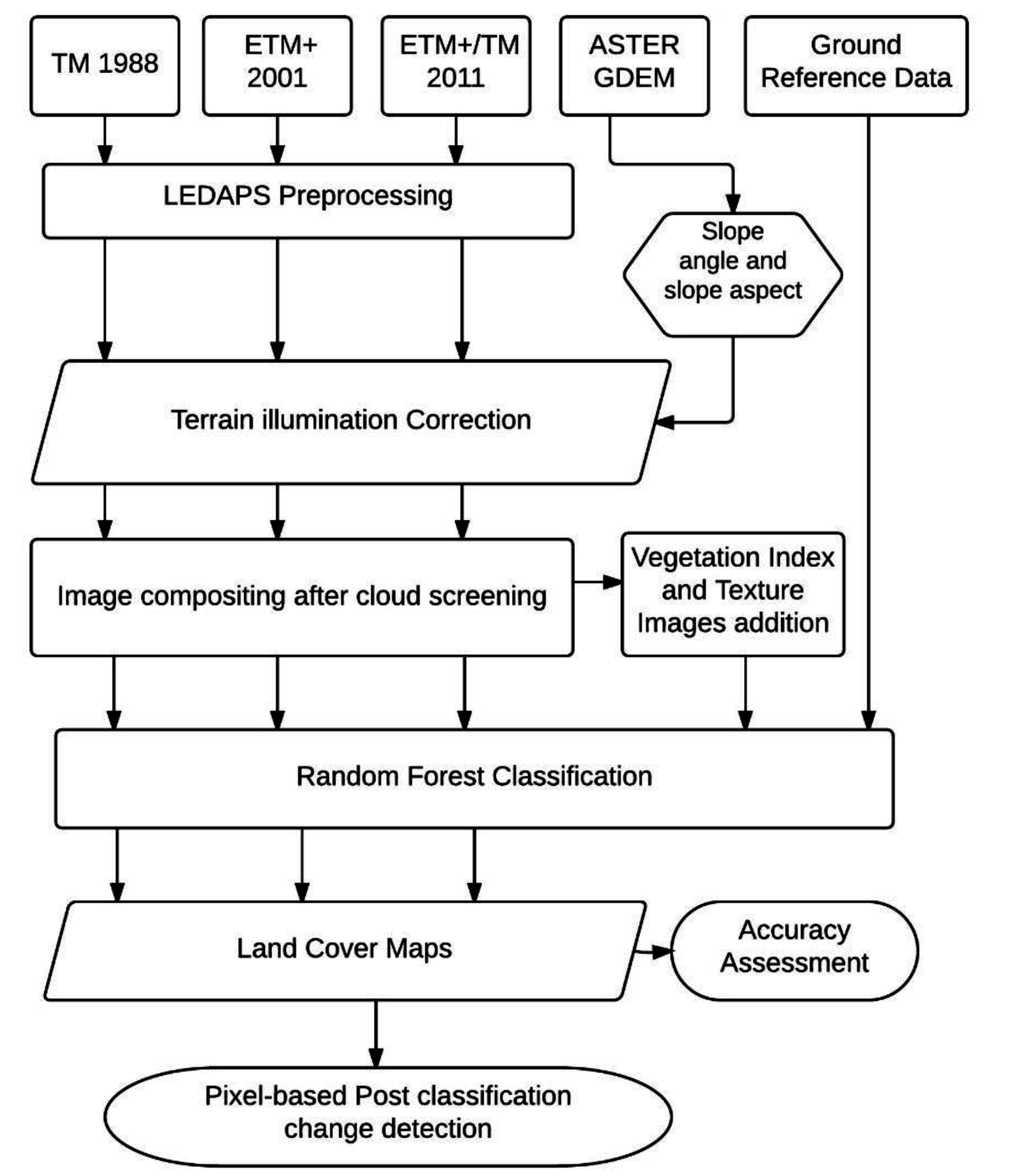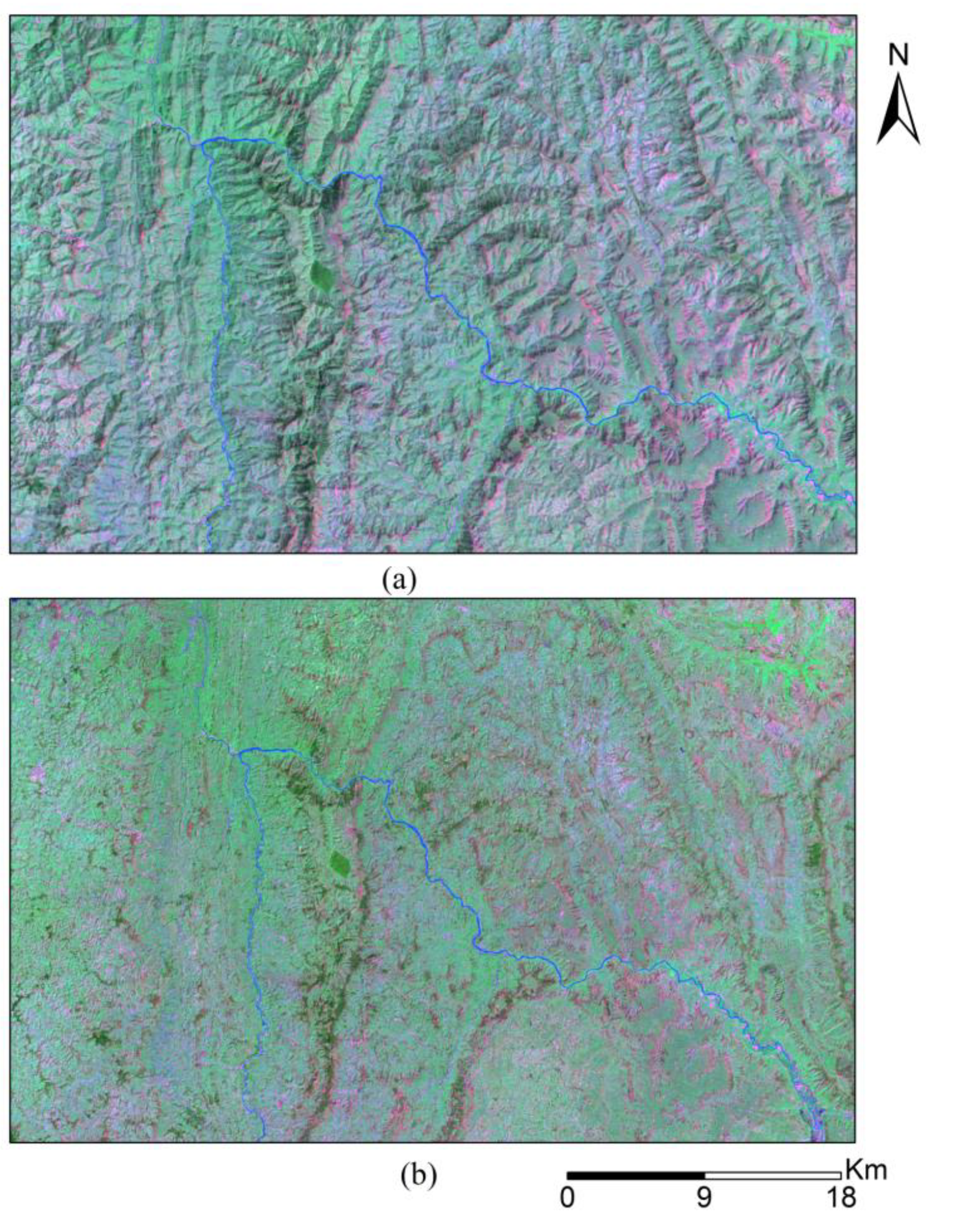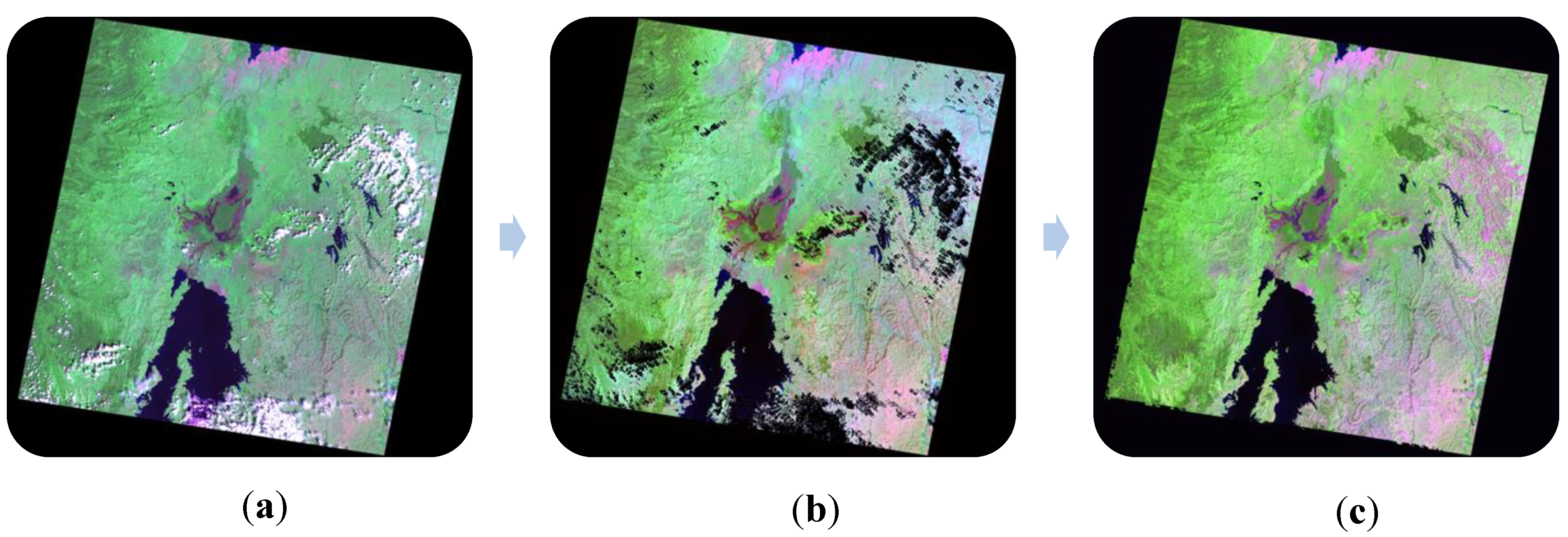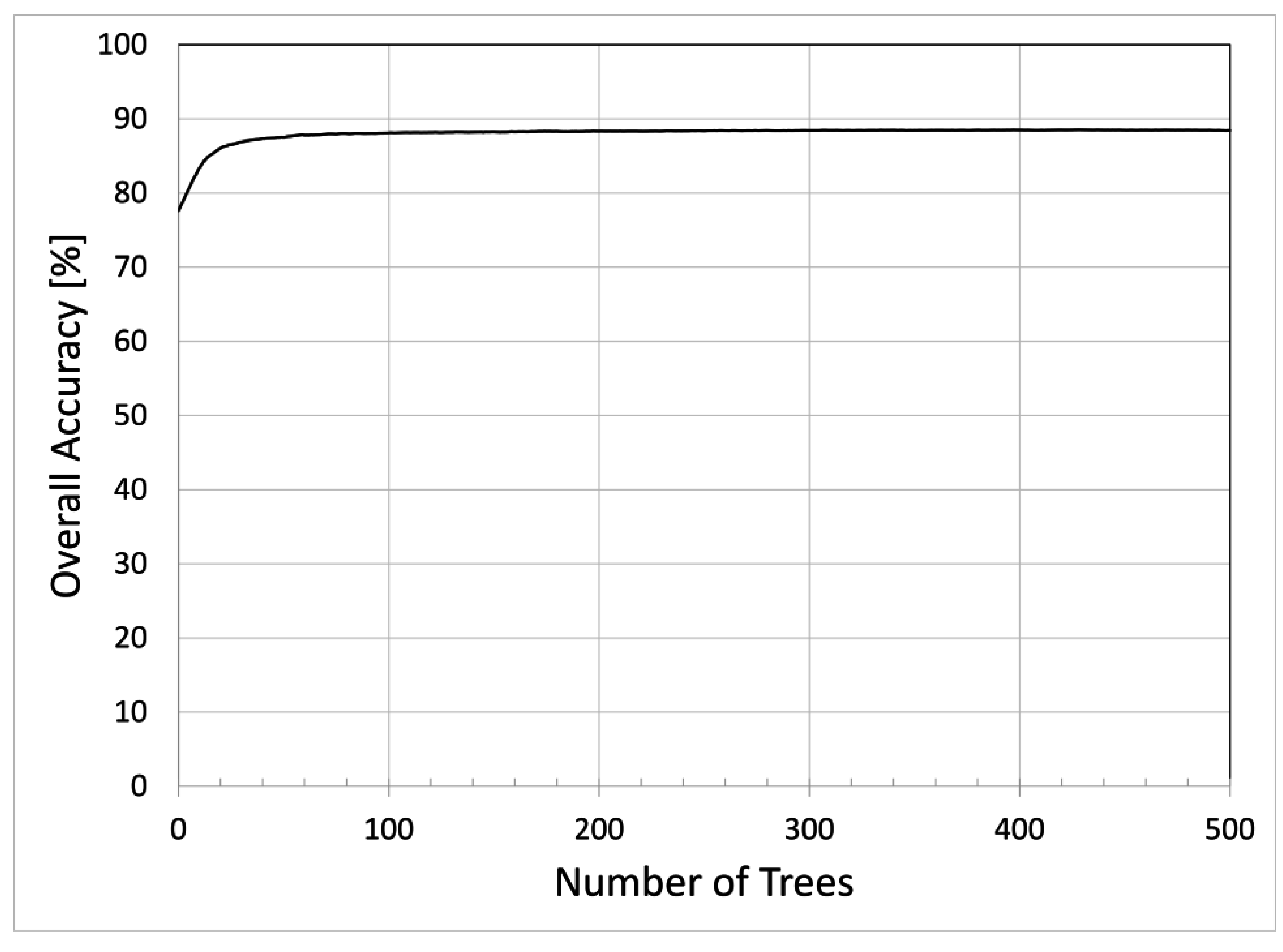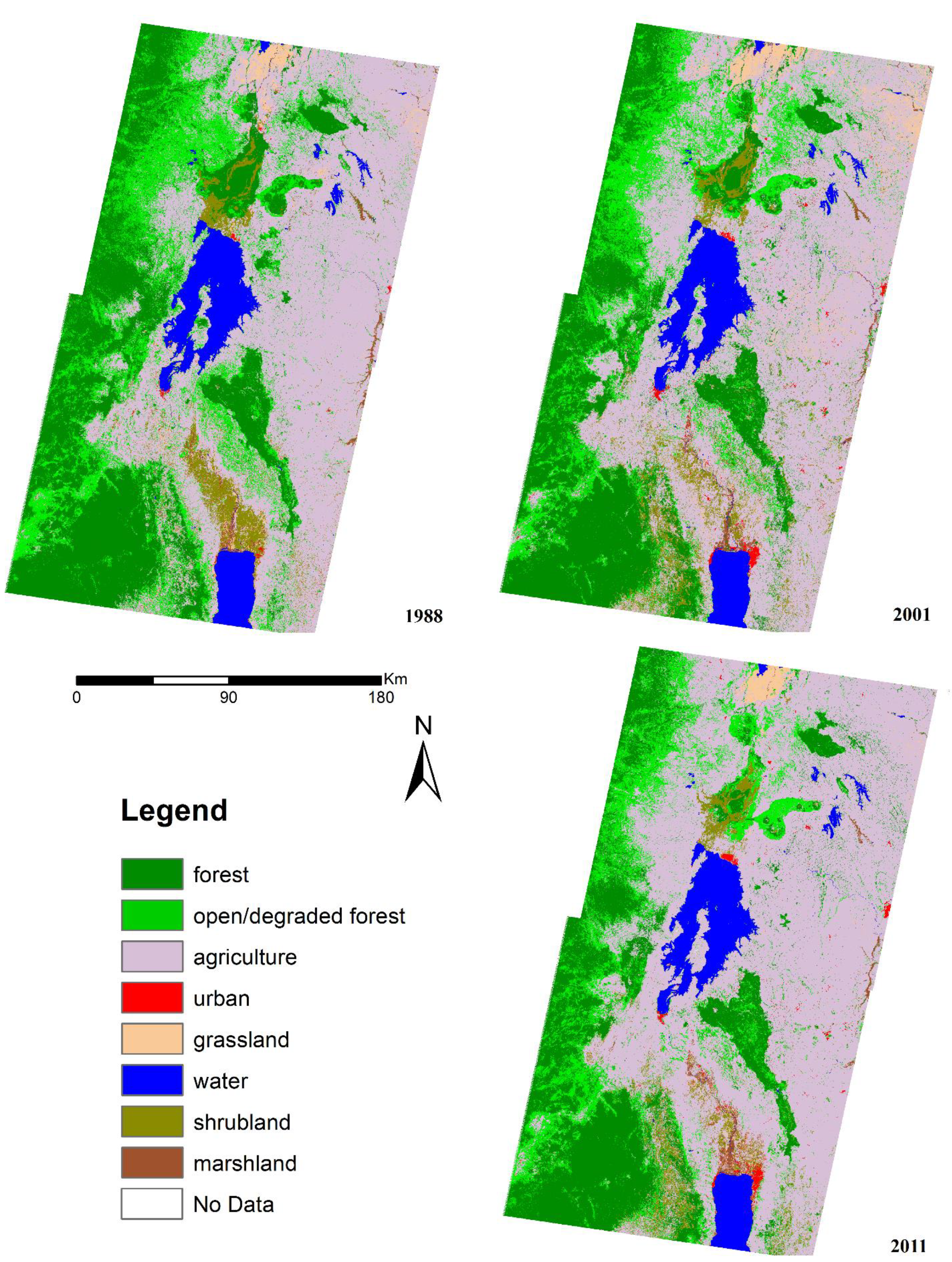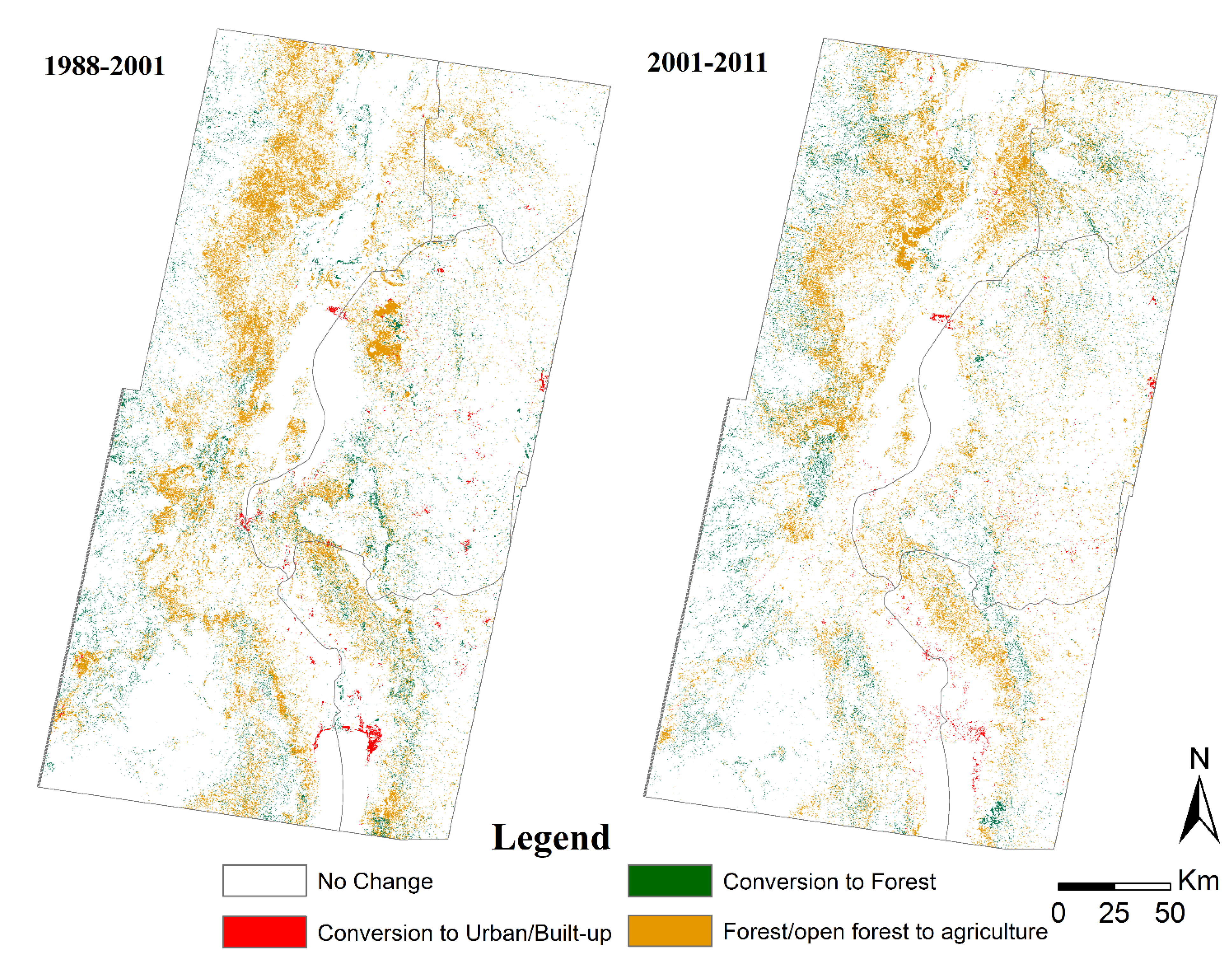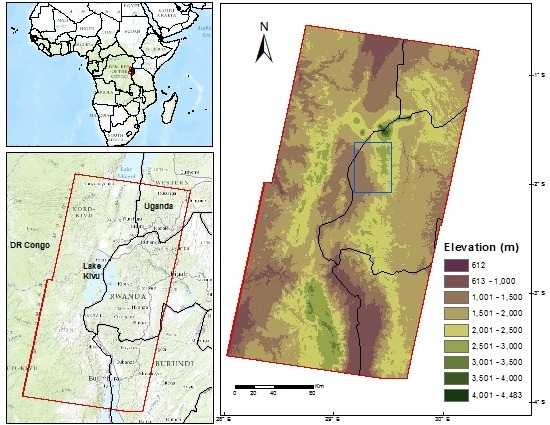4.1. Terrain Illumination Correction
Since LEDAPS processing of Landsat imagery does not include terrain correction, topographic correction was needed to compensate for the very significant terrain illumination effects for the study region. Steep hill and mountain slopes severely affect remote sensing of vegetation. Topography results in shadowed slopes facing away from the sun and brighter slopes facing towards the sun [
55,
56]. This variation in illumination due to the position of the sun at the time of image acquisition and angle of the terrain is identified as the topographic illumination effect. These topographic illumination effects results in significant variation in the observed spectral characteristics of land cover for similar terrain features [
57]. Therefore, topographic correction has become one of the important image preprocessing steps in the application of remote sensing data for land cover change studies in mountainous areas [
58]. Many methods exist to reduce topographic illumination effects for Landsat images [
56,
58,
59,
60,
61]. Vanonckelen
et al. (2013) [
62] achieved high land cover classification accuracy with the combination of a pixel-based Minnaert topographic compensation with an atmospheric correction. Pixel based Minnaert (PBM) correction is chosen over other topographic correction methods in this study due to its higher accuracy [
60]. The slope and aspect angle of the Lake Kivu region terrain were computed from the ASTER DEM as input to the terrain illumination correction for reflectance.
Here,
is the slope of regression between x = log (
) and y = log (
.
is the normalized reflectance of a horizontal surface;
is the observed reflectance on an inclined terrain; β is the incident solar angle;
is the solar zenith angle in degrees;
is the slope angle of the terrain;
is the aspect angle of the terrain; and
is the azimuth angle in degrees.
Figure 3.
Flowchart for the procedures performed in the study.
Figure 3.
Flowchart for the procedures performed in the study.
The topographic compensation was performed for all reference years (1988, 2001 and 2011). An example of the results of topographic compensation is shown in
Figure 4. The shadowed slopes prominent in
Figure 4a are greatly minimized in
Figure 4b. This topographic compensation was an important step to minimize misclassification errors later in the process.
Figure 4.
Landsat color composite (2001) of a hilly region in Rwanda (lat −1.81, lon 29.76; RGB = TM bands 7,4,2) (a) before illumination compensation; and (b) after illumination compensation.
Figure 4.
Landsat color composite (2001) of a hilly region in Rwanda (lat −1.81, lon 29.76; RGB = TM bands 7,4,2) (a) before illumination compensation; and (b) after illumination compensation.
4.2. Image Compositing
To overcome the cloud cover limitations, cloud-free image composites were generated from multi-temporal image scenes covering the region [
28,
63,
64,
65]. A per-pixel based composite method was applied to remove cloud cover. The first step in the formation of a cloud-free composite was removal of cloud and cloud shadows in the Landsat scenes. A cloud-shadow mask was formed using the surface reflectance-based cloud mask
, cloud shadow mask, and adjacent cloud mask provided as additional bands in the Landsat Surface Reflectance CDR product for each Landsat image. The mask was applied to the Landsat scenes to remove cloud and shadow from the scene and minimize their contamination. Since the study area is rarely cloud-free, the most cloud-free image available throughout the year was selected as the primary image for the composite. Next, imagery within ±1 year of the acquisition date of the primary image was selected to form the image composite. Finally, other image data were added to the composite until the final composite with few or no data gaps was formed. A minimum of four to a maximum of six acquisitions per target year were necessary for the composite generation. Care was given to use same season Landsat imagery, where possible, during the composite forming process. The Landsat acquisitions for each target year had an average time gap of 3 years. The list of primary Landsat acquisitions used in the study are given in
Table 1.
Table 1.
Primary Landsat images acquired for land cover classification in Lake Kivu region.
Table 1.
Primary Landsat images acquired for land cover classification in Lake Kivu region.
| Landsat Sensor | Path | Row | Acquisition Date (mm/dd/yyyy) | Area Covered (km2) | Proportion in Final Composite (%) |
|---|
| 5 TM | 173 | 61 | 08/07/1987 | 31,756 | 93.79 |
| 4 TM | 173 | 62 | 08/04/1989 | 29,761 | 87.98 |
| 7 ETM+ | 173 | 61 | 12/11/2001 | 29,333 | 85.58 |
| 7 ETM+ | 173 | 62 | 06/05/2002 | 29,183 | 85.16 |
| 7 ETM+ | 173 | 61 | 10/01/2010 | 24,504 | 69.37 |
| 5 TM | 173 | 62 | 07/08/2011 | 18,904 | 53.97 |
An example of the image compositing results is shown in
Figure 5.
Figure 5a is the primary image from 2001, with clouds at the bottom of the image and in the upper right quadrant.
Figure 5b shows in black the clouds and cloud shadow mask applied in the image.
Figure 5c shows the composite image where data from the other images close in time (±1 year) are used to fill the mask areas. Some areas in the region were cloudy in all images and no replacement for cloudy pixels could be done. Those regions were left with zero values (no data) for further processing. Cloud compositing was completed for all three target years 1988, 2001, and 2011.
Figure 5.
Results of Landsat (RGB = TM bands 7,4,2) time composite formation for the north region (Path/Row 173/61) of the study area. (a) Primary Landsat image collected 11 December 2001; (b) after cloud and shadow removal; and (c) Landsat time composite image.
Figure 5.
Results of Landsat (RGB = TM bands 7,4,2) time composite formation for the north region (Path/Row 173/61) of the study area. (a) Primary Landsat image collected 11 December 2001; (b) after cloud and shadow removal; and (c) Landsat time composite image.
4.3. Vegetation Indices and Textural Images
Selection of suitable features like vegetation indices (VI) and textural images is an important step for successful land cover classification. Textural metrics provide spatial structural information in the input data, while a vegetation index provides information to segregate vegetation from other land cover classes during classification. Rogan and Chen (2004) [
66] states “To be effective, change detection approaches must maximize inter-date variance in both spectral and spatial domains (
i.e., using vegetation indices and texture variables)”. Based on the work by Lu
et al. (2011) [
67], we used two vegetation indices, TC2 and ND42-57 (
Table 2) and two textural images TM2-DIS and TM4-DIS (dissimilarity based on Thematic Mapper (TM) bands 2 and 4). Lu
et al. (2011) [
67] found these to be the best performers among other vegetation indices and textural images through extensive study of separability. They also found the combination of these VIs and texture bands with six Landsat TM bands produced the best overall land cover classification accuracy.
Table 2.
Vegetation indices explained.
Table 2.
Vegetation indices explained.
| Vegetation Index | Equation |
|---|
| TC2 | −0.285TM1 − 0.244TM2 − 0.544TM3 + 0.704TM4 + 0.084TM5 − 0.180TM7 |
| ND42_57 | (TM4 + TM2 − TM5 − TM7)/(TM4 + TM2 + TM5 + TM7) |
4.4. Image Classification
The initial step in the image classification process was to decide on the classes to be examined. Since our goal is to assess land cover change relevant to environmental processes, we implemented a categorical land cover classification system similar to the Africover land cover classes [
7] with the addition of forest cover classes used by Potapov
et al. (2012) [
8].
Table 3 lists the eight broad land cover classes that were assessed: forest, open/degraded forest, agriculture, urban, shrubland, water, grassland, and marshland.
Table 3.
Description of the land cover classes for this study.
Table 3.
Description of the land cover classes for this study.
| Class | Description (Land Use Type) |
|---|
| Forest | Closed forest with 65% or greater canopy and height >5 m; Deciduous, evergreen and mixed forest types. |
| Open/degraded forest | Open forest (canopy cover from 10% to 65%) with open to close shrubs; degraded forest. |
| Agriculture | Areas cultivated with crops such as beans, sorghum, banana, tea, rice, maize, and other seasonal plantations; Pasturelands. |
| Urban | Residential, commercial services, industrial, transportation, roads, built-up land and settlement in villages. |
| Grassland | Areas with annual and perennial grasses. |
| Water | Permanent open water (100% cover), natural lakes, reservoirs and streams |
| Shrubland | Open general shrubs (height 0.5–5 m) with scattered herbaceous and sparse trees in between. |
| Marshland | Mix of water, herbaceous plants and vegetation; Swamps. |
The next step in the process was to choose a suitable image classification method. We used the Random Forests (RF) classification in this study, which has demonstrated excellent performance for the analysis of different remote sensing datasets [
68,
69,
70]. Random Forest, first developed by Breiman (2001) [
71], is an ensemble method for supervised classification and regression based on classification and regression trees (CART). Its main advantage is the non-parametric nature, which does not require data to follow a particular distribution like normal as in case of maximum likelihood classification. Waske
et al. (2009) [
72] found Random Forest classifier outperforming traditional classifiers, namely single decision tree and Maximum Likelihood Classification by improved accuracy of more than 10%. RF works on the robust idea of combining outputs from more than one classifier to improve its accuracy. RF does not overfit, is less sensitive to noise, relatively quick compared to other classification methods like boosting [
71] and better adapted for large datasets [
73]. Compared to larger number of parameters required for other machine learning methods, the RF classifier has only two parameters: the number of trees (T) to grow the whole forest and the number of randomly selected variables (M) chosen as each split. Two methods are used to calculate M in Random Forest, one-third or square root of the number of input variables [
70]. Only two-third of random samples were chosen as training set and remaining one-third samples, called Out-of-Bag (OOB) samples, are used as test samples to compute classification accuracy [
69]. This OOB accuracy is generally plotted against the increment of number of trees to determine appropriate number of trees. Random Forest can also measure the importance of each input variable, which indicates the contribution to classification accuracy. The RF classifier was implemented using ENVI/IDL and the EnMAP-Box software [
74].
Since RF is a supervised classification method, it needs training samples for land cover classification and validation samples for accuracy assessment. Even small amounts of error in the selection of ground selection data can introduce large errors in the land cover change study [
75]. Stehman and Wickham (2011) [
76] argue although a universally best spatial assessment does not exist, the choice of spatial unit has broad implications on the accuracy assessment result. We used the polygon-based training data method suggested by Chen and Stow (2002) [
77] for regions with heterogeneous land cover. An extensive ground reference sample set with each sample size of 7 × 7 pixels was manually selected for all land cover classes separately for each target year 1988, 2001, and 2011 by careful visual inspection of available ground reference data. The reference samples were randomly selected to avoid over- or underestimation of the spectral signature of the land cover [
78]. Visual interpretation of composite Landsat imagery was required for regions where reference data of fine resolution images were not available for that time, namely 1988. Classes covering large regions of the test area were represented by approximately 261 observations (261 7 × 7 samples), while classes covering small regions were represented by a minimum of 30 observations (30 7 × 7 samples) [
78,
79]. The reference sample was then randomly divided in two: one for classification training and other for validation. This was done to make sure training data were spatially independent from the test data. RF was implemented using the reference training sample set in ENVI 4.7. Landsat TM Bands (1–5 and 7), two vegetation indices (TC2 and ND42-57) and two textural images (TM2-DIS and TM4-DIS) were used as input data during the classification process. As a post-classification operation, a 3 × 3 majority filter was applied to the classified maps [
80] to smooth the classified images and only show the dominant classes. This process helped to reduce salt-and-pepper effects in final classification maps due to complexity of the land cover.
The output of the RF classifier exhibited significant confusion between marshland and open/degraded forest, with some of the marshland class occurring on upland sites. To compensate for this, a slope gradient map was created from the ASTER DEM and used as a mask. Marshland class pixels occurring at less than 5 degrees slope were retained while marshland class pixels at sites with greater than 5 degrees slope were converted to open/degraded forest.
4.5. Classification Accuracy and Land Cover Change Assessment
Next, the final results of land cover classification were used for accuracy assessment. Accuracy refers to degree of ‘correctness’ of a thematic map or classification [
10]. Accuracy assessment refers to the extent of correspondence between remote sensing data and reference information and is based on confusion matrices using producer’s accuracy, user’s accuracy for each class, overall accuracy and the Kappa statistic for each classification scenario [
81,
82]. The user’s accuracy is the probability of any classified pixel to represent the correct class and the producer’s accuracy is the probability that a pixel of a known class is classified into a correct class [
81]. Kappa coefficient measures the overall agreement between reference data and the classified thematic map and is considered to be a better indicator of accuracy [
58,
83]. The previously described validation data set was used for the accuracy assessment.
Change detection is the process of identifying differences in the state of an object or phenomenon by observing it at different times [
84]. The post classification change detection method produces not only change maps as do pre-classification methods, but it also identifies the nature (from-to) of change of land cover [
14,
85]. These methods use separate classification of images acquired at different times and quantifies the different types of change between those intervals [
15]. Land cover change assessment was performed using pixel based post-classification change detection algorithm. The most popular approach of post-classification change detection is bi-temporal change analysis of classified maps [
86]. This technique was used to determine land cover change in the region for three intervals, 1988–2001, 2001–2011 and 1988–2011. ENVI 4.7 software was used to obtain the change detection results.
